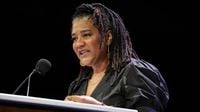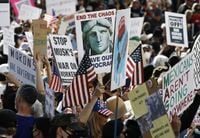Across the United States, an unprecedented wave of artistic resistance swept through cities and towns on November 21 and 22, 2025, as the Fall of Freedom movement staged more than 600 events in response to what organizers describe as mounting authoritarian threats. Conceived by a coalition of prominent artists, including playwright Lynn Nottage, visual artist Dread Scott, Accra Shepp, and Miguel Luciano, Fall of Freedom set out to "activate a nationwide wave of creative resistance" and rally the American arts community against censorship, self-censorship, and policies that undermine democratic participation.
From New York City’s bustling parks and subway stations to the streets of Albuquerque and the steps of Washington, DC’s Kennedy Center, artists, cultural workers, and community members gathered in solidarity. Each event reflected its organizers’ unique vision for dissent, but all shared a common goal: to remind the nation that the arts are both a celebration and a safeguard of freedom of expression.
According to DC Theater Arts, the nation’s capital hosted two major events in coordination with the national day of action. On Friday, November 21, Woolly Mammoth Theatre Company welcomed citizen-artists to a Fall of Freedom Town Hall. Facilitated by Sheldon Scott, the theater’s Connectivity Artist-in-Residence, the gathering encouraged attendees to share personal experiences and discuss the urgent need to protect artistic expression and freedom of speech. The event, which began with a community happy hour, sought to build a "living archive of our time"—a testament to the anxieties and hopes of artists living in Washington, DC.
The following day, the focus shifted to the John F. Kennedy Center for the Performing Arts, where Hands Off the Arts and The Movement Movement organized a protest drawing over 50 participants. The demonstration, marked by dance performances and impassioned speeches from recently dismissed Kennedy Center workers, called attention to what organizers labeled as escalating threats to artistic freedom and labor rights since President Donald Trump assumed the role of chairman at the Kennedy Center earlier in 2025. Protesters demanded the reinstatement of the Center’s Dance Programming staff and immediate recognition of the Kennedy Center United Arts Workers labor union. Attendees—encouraged to wear orange or red—were even given a crash course in protest choreography, underscoring the movement’s belief in art’s power to galvanize collective action.
But the capital was far from alone in its activism. As Artnet News reported, New York City was a veritable epicenter for Fall of Freedom, boasting nearly 200 projects. These ranged from a participatory art action by the cooperative ABC No Rio in Madison Square Park to a video installation by Los Herederos in the Jackson Heights-Roosevelt Ave subway station. The NYC Resistance Salon rolled through the city with a digital billboard displaying political cartoons critical of the Trump administration, while the Banned Book Brigade donned sandwich boards featuring the covers of their favorite censored books on the steps of the New York Public Library. Major galleries and museums—including 601ArtSpace, Jack Shainman Gallery, Cristin Tierney Gallery, Ronald Feldman Fine Arts, El Museo del Barrio, and the Bronx Museum—joined in with exhibitions and retrospectives dedicated to artists known for challenging the status quo.
One of the weekend’s marquee events was the Creatives For Freedom benefit concert at Pioneer Works, headlined by Sheryl Crow and featuring artists such as Mark Ronson, St. Vincent, and Maggie Rogers. The concert, which raised funds for the ACLU’s civil rights initiatives, embodied the movement’s blend of artistry and activism.
In Washington, DC, another creative protest unfolded as ArtWatchV2.0 staged a guerrilla performance titled Gold is Gauche. Artists dressed in French courtly costumes paraded through the city, distributing buttons emblazoned with an image of Trump as Marie Antoinette—a satirical jab at perceived excess and detachment from everyday Americans. As the group explained, "We will proclaim to the people the satire of our gilded decline and, with camp precision, stage the queering of Trump’s ‘Big beautiful BALLS room,’ laying bare its cost—literal and psychic—to the American people." Even California Governor Gavin Newsom joined the fray online, posting an AI-generated portrait of Trump as Marie Antoinette and quipping, "TRUMP ‘MARIE ANTOINETTE’ SAYS, ‘NO HEALTH CARE FOR YOU PEASANTS, BUT A BALLROOM FOR THE QUEEN!'" on X.
Meanwhile, in New Mexico, the movement took on a distinctly local flavor. As reported by KRQE News, artist Sheri Crider and the Gizmo Artspace in downtown Albuquerque orchestrated a protest featuring the dramatic unfurling of two 50-foot banners and a performance by High Desert Playback Theatre. The event was one of several in the region, including a gallery show of political and protest art by eight women artists, a banned books read-in and roundtable at the Maxwell Museum, and a public reading of the children’s book And Tango Makes Three—the true story of two gay penguins—by cardigan-clad volunteers. In Santa Fe, the Monroe Gallery of Photography hosted a pop-up exhibit spotlighting photojournalism for justice and social change, while The Apparatus Collective’s "A Wake for Democracy" invited visitors to reflect on the state of American democracy. Across Taos, small works of protest art appeared in grocery stores, cafes, and libraries, a subtle but persistent reminder of the movement’s reach.
Fall of Freedom’s organizers were candid about their motivations and hopes. Accra Shepp, one of the project’s initiators, described the weekend as “a cultural roadblock,” telling Artnet News, “You won’t be able to scratch your nose or turn your head without bumping into a movie, or a video on your phone, or something you read. It will be everywhere. You will be reminded that the rule of law matters and that the arts—they not only celebrate freedom of expression, they are the reason for freedom of expression.” Miguel Luciano, another key organizer, emphasized the importance of solidarity and action: “We all need to do something right now—the integrity of our institutions is on the line.”
The movement’s website provided an interactive map to help supporters find local events, and organizers expressed hope that the momentum would build, drawing in more artists and institutions in the future. Notably, the absence of many major institutions was seen as a challenge to be overcome, rather than a reason for despair. “We were hoping that people would respond to this idea of wanting to do something. We all are frustrated with what’s happening in the country, and frustrated that a lot of the institutions that we care about and often work with are cowering in silence, whether they’re universities or museums. People are afraid, and they’re self-censoring and silencing in different ways,” Luciano told Artnet News.
For many, the Fall of Freedom weekend was more than a protest—it was an affirmation that, even in uncertain times, the arts remain a powerful force for dialogue, dissent, and hope. As Shepp put it, the work of these two days stands as "a reminder that action is possible... that the courage to speak freely, to exercise one’s right as an artist, to be a participant, as a viewer in an artwork or action, this is what we’re celebrating, and that we shouldn’t be fearful."
As the banners came down and the last performances ended, one thing was clear: the American arts community had spoken, and its message of creative defiance echoed from coast to coast.





